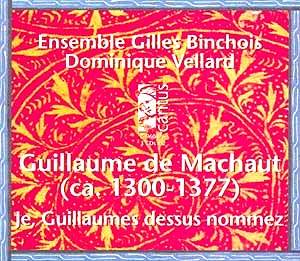 |
Guillaume de MACHAUT(ca.
1300-1377) Je, Guillaumes dessus nommez Le Jugement de Roi de Navarre * [65.25] Messe de Nostre Dame ** [56.45] Le vray remede díamour *** [68.25] Rec: * October 1994, Eglise de Grancey le Ch‚teau, France; ** September 1990, CollÈgiale Saint-Martin de Champeaux, France; *** October 1988, Eglise Saint-Martin de la Motte Trenant, France. Crotchet AmazonUK AmazonUS Amazon recommendations |
Guillaume de Machaut was one of the great composers of a pivotal period at the intersection between the late medieval period and the Renaissance. His works include sacred compositions, such as his Messe de Nostre Dame, which took polyphonic music to new summits, as well as popular dances and songs that reveal the influence of the troubadours and trouveres.
The first CD in this set, Le Jugement du Roi de Navarre (The Judgement of the King of Navarre), is a series of chansons, motets, ballades, virelais and other works grouped around a selection of texts from the poem of the same name. These various musical works provide interludes between the spoken texts of the different parts of the poems. Ranging from hypnotic Puisque ma dolour, with its repetitive viele melodies, to more lively, dance-like works, such as J'aim sans penser, to polyphonic works, in the same style as the Guillaume's mass, this disc gives an overview of the many types of music this pivotal composer wrote. I have to react, however, to one element of this performance: while there is no way to know exactly how any of this music was performed - and the extensive liner notes discuss this - I feel pretty sure in saying that Old French was not pronounced as it is on this recording, in the spoken texts. While it is understandable to pronounce it in a way that modern (French-speaking) listeners can understand, talking about the 'fascinating beauty of the Old French' seems a bit out of place. Nevertheless, the music is performed admirably, and the program itself is well-constructed. But listeners expecting only music may be put off by the many spoken tracks - of course, you can always program them out.
Guillaume de Machaut's Messe de Nostre Dame is one of the essential masterpieces of medieval polyphony, and stands out by being one of the longest. Its unique textures and intervals give it an otherworldly sound, and the singers on this recording weave their voices together in a perfect performance, with exquisite balance and an excellent overall tone. The mass itself is made up of several movements interspersed with recitatives and other sections. The mass movements (the Kyrie, Gloria, Credo, Sanctus, Agnus Dei and Ite Missa Est) all feature four voices in polyphonic singing. The other movements are in Gregorian Porprium, or plainchant, for one, three or four voices. This is definitely one of the best recordings of this work. (Another excellent recording of this work is that by Andrew Parrott and the Taverner Consort. While both have excellent texture and tone, the Ensemble Gilles Binchois version is sung at a lower tone, and many of the mass movements are much slower, giving it a more solemn sound.)
The third disc is called Le vray remede d'amour (The True Remedy of Love). Like the first disc, it is a selection of ballades, rondeaux, virelais, motets and spoken texts (although there are fewer spoken texts; only six). This disc covers the same styles and forms as the first recording in this set. Some of the pieces have a distinct Middle Eastern influence, which can be heard in the droning tones and modes, such as Dame, vostr doulz viaire. Others, such as Dame se vous m'etese lonteinne are more lively, and sound more like dances. Anne-Marie Labaude's voice is splendid in Je ne cuit pas, a simple, haunting song featuring voice and gittern, a lute-like instrument. Doulz amis is a beautiful song for two male voices, that uses the more 'classical' polyphonic style of singing in a non-sacred setting; its harmonies are a fine example of how Guillaume could write simple melodies and arrange them with unique, even surprising intervals.
To sum up, this is probable the best set of Guillaume de Machaut's works available. The performances are excellent, the sound nearly perfect, and the programs (for the two discs other than the mass) are well composed. Cantus's high standards of packaging and textual accompaniment make this not only an attractive set but a pedagogical one as well. At the price - three discs for the price of two - you cannot go wrong if you want to discover the works of one of the greatest composers of the late medieval period, or if you want to discover more of his music. (Note: these recordings are repackagings of the original recordings on Harmonic Records.)
An excellent set of the works of Guillaume de Machaut, performed admirably by one of the best ensembles for this type of music. At a three-for-two price, you can't go wrong with this set.
Kirk McElhearn